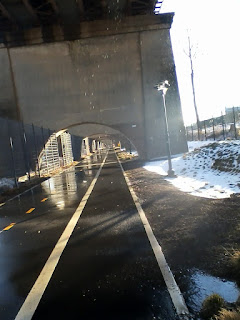All you have to do is look at Arielle, Tosca and Helene--my three custom Mercians--to know what my favorite color is.
And, although I am more of a Purple Haze fan, I certainly loved Purple Rain--and the artist who made it his signature song.
I am talking about His Royal Badness, or The Artist Formerly Known As The Artist Formerly Known As Prince. It's hard to believe that in not much more than two weeks, a year will have gone by since he left us.
Not surprisingly, there have been some lavish tributes. But perhaps none is as unique or interesting as the one Erik Noren has just made for Anna Schwinn.
Yes, she is one of those Schwinns. She had contacted Noren of Peacock Groove Bicycles about getting a custom bike built for her. Then, after Prince's death, she decided to make it a tribute.
Although Noren has built tribute bikes and other machines in unconventional configurations, he says he was intimidated at first. "How do you take his spirit, his music and what he did, and put that into a bike?," he wondered.
The first thing he thought about, he said, was style. Prince "was never gaudy," Noren explained. "He was always classic and classy." After he constructed a color scheme and theme, word got out about his project. Soon he received messages from vendors and even associates of Prince himself, offering to donate items and materials to be used in the commemorative cycle.
Noren is justified in believing that what he turned out befits its namesake. Last month, it won awards for the Best Theme and Best Bike In Show at the North American Handmade Bicycle Show. While he is happy about the awards, he believes the greatest validation came from an audience of one: Ms. Schwinn herself.
She took the bike out for a ride around Lake Minnetonka--only a few pedal strokes, if you will, from Prince's home--and dipped the wheels in the water. Noren is glad she did that: As visually striking as the bike is, he believes that it, like any other bike, "needs to be ridden." The scratches and dings a bike picks up are "like scars on people: they tell a story." He is "excited that she's out making new stories on that bike."
I think the Purple One himself would approve.
And, although I am more of a Purple Haze fan, I certainly loved Purple Rain--and the artist who made it his signature song.
I am talking about His Royal Badness, or The Artist Formerly Known As The Artist Formerly Known As Prince. It's hard to believe that in not much more than two weeks, a year will have gone by since he left us.
Not surprisingly, there have been some lavish tributes. But perhaps none is as unique or interesting as the one Erik Noren has just made for Anna Schwinn.
 |
| Anna Schwinn with her Prince tribute bike. |
Yes, she is one of those Schwinns. She had contacted Noren of Peacock Groove Bicycles about getting a custom bike built for her. Then, after Prince's death, she decided to make it a tribute.
 |
| Erik Noren of Peacock Groove Bicycles |
Although Noren has built tribute bikes and other machines in unconventional configurations, he says he was intimidated at first. "How do you take his spirit, his music and what he did, and put that into a bike?," he wondered.
The first thing he thought about, he said, was style. Prince "was never gaudy," Noren explained. "He was always classic and classy." After he constructed a color scheme and theme, word got out about his project. Soon he received messages from vendors and even associates of Prince himself, offering to donate items and materials to be used in the commemorative cycle.
Noren is justified in believing that what he turned out befits its namesake. Last month, it won awards for the Best Theme and Best Bike In Show at the North American Handmade Bicycle Show. While he is happy about the awards, he believes the greatest validation came from an audience of one: Ms. Schwinn herself.
She took the bike out for a ride around Lake Minnetonka--only a few pedal strokes, if you will, from Prince's home--and dipped the wheels in the water. Noren is glad she did that: As visually striking as the bike is, he believes that it, like any other bike, "needs to be ridden." The scratches and dings a bike picks up are "like scars on people: they tell a story." He is "excited that she's out making new stories on that bike."
I think the Purple One himself would approve.






























